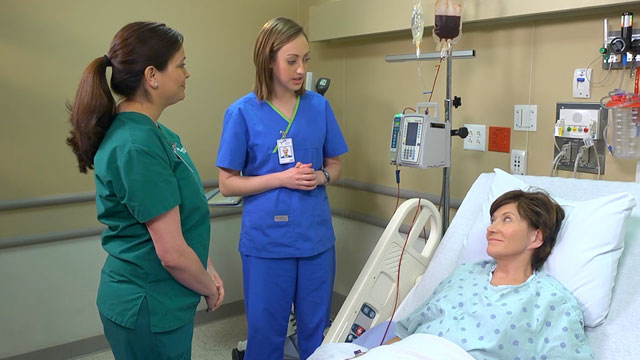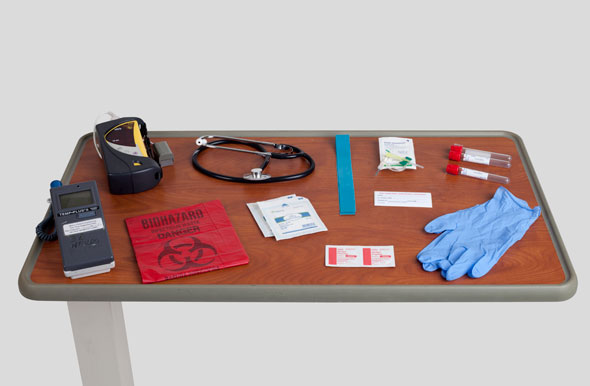Transfusion of Blood and Blood Products
Select a Skill:
- » Preparing for a Transfusion
- » Initiating a Transfusion
- » Monitoring for Adverse Reactions to a Transfusion
Take the Review Test:

Safety
- When preparing and administering blood or blood components and when monitoring a transfusion, pay meticulous attention to detail to prevent life-threatening transfusion reactions. Be sure you know the onset, signs and symptoms, typical interventions, and your agency’s policies for each of the following types of reactions:
- Febrile, nonhemolytic
- Acute hemolytic
- Delayed hemolytic
- Allergic (mild to moderate)
- Allergic (severe)
- Graft-versus-host disease
- Circulatory overload
- Infectious disease transmission
- Iron overload
- Life-threatening reactions usually occur within 15 minutes of initiating a transfusion. Remain with the patient during this time to monitor his or her physiologic responses.
- Report sepsis and other infections caused by a transfusion to the blood bank and to your agency’s infection control department, which will communicate the information to the state health department and to the Centers for Disease Control and Prevention (at U.S. agencies).
Equipment
(Roll cursor over items to see labels)

Stethoscope
Thermometer
Pulse oximeter
Biohazard disposal bag
Tourniquet
Blood collection tubes
Blood collection needle with Vacutainer
Labels for blood collection tubes
Alcohol swabs
2x2 gauze pads
Clean gloves
Delegation
The skill of monitoring for adverse blood transfusion reactions may not be delegated to nursing assistive personnel. Delegation to licensed practical nurses (LPNs) is specified by each state’s Nurse Practice Act.
NAP may monitor a patient after the blood transfusion is started and the patient’s stability has been confirmed. Such monitoring does not relieve the registered nurse (RN) of the responsibility for continuing to assess the patient during the transfusion. Be sure to inform NAP of the following:
- Specify the frequency with which vital signs should be monitored.
- Review the information that should be reported to you immediately, including complaints of shortness of breath, hives, or chills.
Preparation
- When a transfusion is initiated, observe or assess the patient for the following:
- Fever with or without chills
- Tachycardia and/or tachypnea and dyspnea
- Drop in blood pressure
- Hives or skin rash, including assessment of the trunk and back
- Flushing
- Gastrointestinal symptoms
- Wheezing, chest pain, and possible cardiac arrest
- Patient complaints of headache or muscle pain in the presence of fever
- Monitor the patient for disseminated intravascular coagulation (DIC), renal failure, anemia, and hemoglobinemia/hemoglobinuria by reviewing laboratory test results, including complete blood count (CBC) with differential, hemoglobin (Hgb), and hematocrit (Hct).
- Auscultate the patient’s lungs, and monitor central venous pressure (CVP) if possible.
- Observe the patient for jaundice and increased liver enzyme levels, indicating liver damage, and monitor for decreased red blood cells (RBCs), white blood cells (WBCs), and platelets, indicating bone marrow suppression.
- In patients receiving massive transfusions, observe for mild hypothermia, cardiac dysrhythmia, hypotension, hypocalcemia, and hemochromatosis (iron overload).
Follow-up
- Observe the IV site and status of the infusion each time vital signs are taken.
- Continue monitoring the patient for signs and symptoms of transfusion reactions.
- Observe the patient and assess laboratory values to determine the patient’s response to administration of the blood component.
- If signs of a transfusion reaction occur, stop the transfusion, start normal saline with new, primed tubing attached directly to the venous access device, and notify the health care provider immediately. Do not infuse saline through the existing tubing because it will cause the blood in the tubing to enter the patient.
Documentation
- Document in the medical record the exact time at which the transfusion reaction was first noted. Document all vital signs and other physiologic assessments, all treatments instituted, and the patient’s response. Complete the transfusion reaction report according to your agency’s policy.
- Immediately report the occurrence of a transfusion reaction and the patient’s physical assessment findings to the nurse in charge and to the health care provider.
Review Questions
1. A patient receiving a unit of blood complains of feeling cold and begins to have shaking chills. What is the nurse’s first action?
 Measure the patient’s temperature.
Measure the patient’s temperature. Measure the patient’s blood pressure.
Measure the patient’s blood pressure. Stop the transfusion.
Stop the transfusion. Place a warmed blanket over the patient.
Place a warmed blanket over the patient.
2. A patient has a blood transfusion reaction, and the transfusion is stopped. What should the nurse do with the remaining blood and transfusion administration set?
 Return both to the blood bank.
Return both to the blood bank. Return the blood to the blood bank, and discard the tubing.
Return the blood to the blood bank, and discard the tubing. Discard both the blood and tubing.
Discard both the blood and tubing. Send the blood and the tubing to the laboratory for analysis.
Send the blood and the tubing to the laboratory for analysis.
3. A patient receiving a unit of blood begins to show signs of a transfusion reaction. How frequently should the nurse monitor the patient’s vital signs after stopping the transfusion?
4. A patient experiencing a blood transfusion reaction is prescribed to receive epinephrine. What is the purpose of this medication when given for this indication?
 To relieve respiratory distress
To relieve respiratory distress To block histamine receptors
To block histamine receptors To reduce circulatory overload
To reduce circulatory overload To combat bacterial infection
To combat bacterial infection
5. It is determined that a patient who received a blood transfusion received an infection from the blood. Whom should the nurse notify of this infection?
 Blood bank and infection control department
Blood bank and infection control department State health department
State health department U.S. Centers for Disease Control and Prevention
U.S. Centers for Disease Control and Prevention  Centers for Medicare and Medicaid or the patient’s private insurer
Centers for Medicare and Medicaid or the patient’s private insurer
You have completed the Review Questions for this skill. To take the Review again select the Start Over button. To proceed to another skill select from the dropdown menu. Select the Home or Back button to proceed to the next section.

